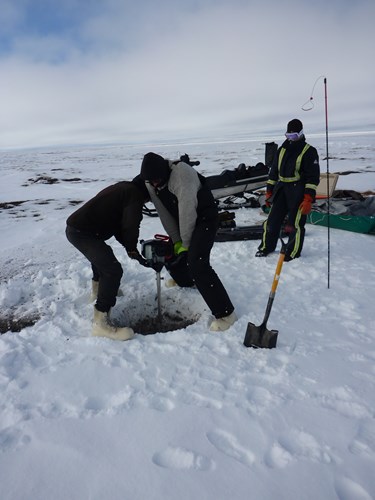- Dec 2
- Children of the Arctic
- Apr 18
- Snow, Wind, and Ice
- Apr 16
- Lesson from the Arctic
- Apr 14
- I Love Doing Science!
- Jan 28
- Bouncing Back in Whiteness
- Jan 27
- The Magical SAR Queen Rules!
- Jan 26
- Arctic Winter Science
- Jan 25
- A Day to Chill
5/2/2016
Yesterday the sun was out in full force and seemingly all night. This after a long period of overcast skies and warm stable temperatures just below zero degree C (32 F).

Water is the standard medium to gauge temperature. Because of phase change (ice-to-liquid-to-vapor) and the energy involved with it, temperatures tend to remain near zero for longer periods as water freezes or thaws. The near surface atmosphere (where we’re living) holds a lot of water and current temperatures suggest we’re in coming into the zero degree curtain (ZDC). Compared to the last 9 years we’ve been doing these trips, we seem to be about 10-15 days ahead of schedule in Arctic thawing. This may not sound like much, but given that Arctic summers (above zero degree days) only last about 100 days on average, that’s significant.

The instability of weather and the atmosphere however, provide a relatively poor example of the ZDC. Shallow lake bed sediments provide a great example because they are overlain by water and freeze solid at some point over the winter and then thaw from the top down in the early summer. Freezing ZDC’s can last for a month or more in some years and thawing ZDC’s are typically faster.

The actively layer (seasonally thawed zone) above permafrost is another very good example showing ZDC’s two times a year. Around here the ice-content of permafrost is very high, possibly making it less sensitive to thaw. But when it does, the impacts are severe, causing subsidence of the ground and other destabilities collectively known as thermokarst. This is what forms most lakes in this area and also causes high rates of coastal erosion, road repairs, and special pipeline structures to prevent heat transfer into the ground.

We are collecting permafrost cores to quantify ground ice content in order to evaluate susceptibility of permafrost to things like lake shoreline erosion. Coring is very hard work and the perfect job for a scrapping young grad student like Allen B. Getting a hot core barrel stuck in the -10 deg C permafrost is business as usual and getting it out seems half the fun.

Where is the Arctic in the context of a long-term zero degree curtain? Currently still well below freezing and likely to remain that way for some time, but with winters like this one its hard to be certain.